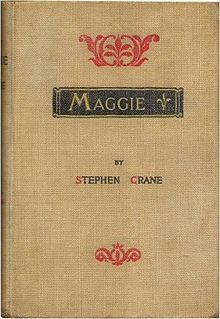- Maggie: A Girl of the Streets
-
Maggie: A Girl of the Streets is an 1893 novel by American author Stephen Crane. Often called a novella because of its short length, it was Crane's first published book of fiction. Because the work was considered too risqué by publishers, Crane, who was 21 years old at the time, had to finance the publication of the novel himself. The novel takes place in the Bowery, a New York neighborhood in lower Manhattan.
Contents
Plot summary
The story opens with Jimmie, at this point a young boy, trying to fight a gang of boys from an opposing neighborhood all by himself. He is saved by his father, and comes home to his sister Maggie, his toddling brother Tommie, his brutal and drunken father and mother, Mary Johnson. The parents terrify the children until they are shuddering in the corner. Years pass, the father and Tommie die, and Jimmie hardens into a sneering, aggressive, cynical youth. He gets a job as a teamster. Maggie begins to work in a shirt factory, but her attempts to improve her life are undermined by her mother's drunken rages. Maggie begins to date Jimmie's friend Pete, who has a job as a bartender and seems a very fine fellow. He takes her to the theater and the museum. One night Jimmie and Mary accuse Maggie of "Goin to deh devil." Jimmie goes to Pete's bar and picks a fight with him (even though he himself has ruined other boys' sisters). As the neighbors continue to talk about Maggie, Jimmie and Mary decide to join them in badmouthing her instead of defending her. Later, Nellie, a "woman of brilliance and audacity" convinces Pete to leave Maggie, whom she calls "a little pale thing with no spirit." Thus abandoned, Maggie tries to return home but is rejected by her mother and scorned by the entire tenement. In a later scene, a prostitute, implied to be Maggie, wanders the streets, moving into progressively worse neighborhoods until, reaching the river, she is followed by a grotesque and shabby man. The next scene shows Pete drinking in a saloon with six fashionable women "of brilliance and audacity." He passes out, whereupon one, possibly Nellie, takes his money. In the final chapter, Jimmie tells his mother that Maggie is dead. The mother exclaims, ironically, as the neighbors comfort her, "I'll forgive her!"
Historical context
Maggie was published during the time of industrialization.[1] The United States, a country shaped by agriculture in 19th century, became an industrialized nation in the late 1800s. Moreover, "an unprecedented influx of immigrants contributed to a boom in population," creating bigger cities and a new consumer society. By these developments, progress was linked with poverty, illustrating that the majority of the US population was skeptical about the dependency on the fluctuation of global economy.[2]
Naturalism
Maggie is "regarded as the first work of unalloyed naturalism in American fiction."[3] According to the naturalistic principles, a character is set into a world where there is no escape from one's biological heredity. Additionally, the circumstances in which a person finds oneself will dominate one's behavior, depriving the individual of responsibility.[4] Although Stephen Crane denied any influence by Émile Zola,[5] the creator of Naturalism, on his work, examples in his texts indicate that this American author was inspired by French naturalism.
Main characters
- Jimmie Johnson- a young boy, Maggie and Tommie's brother, who first appears in the beginning scene fighting a gang war of some sort with the Rum Alley Children.
- Pete- a teenager, in the beginning, who is an acquaintance of Jimmie, and saves Jimmie in the fight
- Father- brutal, drunkard, father of Jimmie, Maggie, and Tommie
- Maggie Johnson- eldest child, protagonist of the story, apparently immune to the after-effects of the negative family, prostitute (at the end of the story, an implication)
- Tommie Johnson- youngest child
- Mary Johnson- drunkard mother, also brutal
Notes
- ^ Holton, Milne. Cylinder of Fiction. - The Fiction and Journalistic Writing of Stephen Crane. Baton Rouge: Louisiana State UP, 1972. 37.
- ^ Holton, 54
- ^ Holton, 37
- ^ Columbia Literary History of the United States. Ed. Emorz Elliott. New York: Columbia UP, 1988. 525-45.
- ^ Holton 52
External links
Categories:- 1893 novels
- Debut novels
- Novels by Stephen Crane
- Novels about prostitution
- Novellas
- Novels set in New York City
Wikimedia Foundation. 2010.

